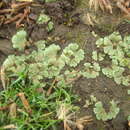Comprehensive Description
provided by North American Flora
Riccia crystallina L. Sp. PL 1138. 1753
Riccia Catalinae Underw. Bot. Gaz. 19: 275. 1894. Riccia Brandegei Underw. Bot. Gaz. 19: 275. 1894. Ricciella crystallina Warnst. Krypt.-fl. Brand. 1 : 80. 1902.
Thalli small to moderately large, 2-6 times dichotomous, forming rosettes 5-20 mm. (rarely 30 mm.) in diameter, or soon irregularly gregarious, usually a light crystalline green or often yellowish-green above, occasionally dark-green or now and then tinged with red-purple or brownish-red, concolorous below, the dorsal surface vesicular-areolate, soon becoming spongiose or lacunose-alveolate, especially on drying; main segments subquadrateobovate to obcuneate-oblong or linear-oblong, 1-2.5 mm. wide; terminal segments subquadrate-obovate or obcordate, obtuse or subtruncate, emarginate; margins obtuse or subacute, naked, sometimes reddish -purple or brown-red; median sulcus usually rather poorly defined except at apex; scales wanting or rudimentary; transverse sections subelliptic, oblong, or somewhat parabolic, mostly 2-4 times as broad as high, the ventral outline convex or nearly rectilinear; dorsal epidermis soon indeterminate, the cells of the primary stratum subspheric, ellipsoidal, or papilliform, irregularly collapsing or subpersistent, they or their successors finally 40-110 ;* in maximum diameter; air-chambers elongate-polyhedral, separated by unistratose lamellae, and showing 2-4 vertical series in a transverse section. Monoicous (rarely dioicous?); antheridial ostioles elevated 75-250 ju; capsules moderately numerous, often rather long included; spores at first yellowish -brown, soon darkening and often nearly opaque, 60-110 fj. in diameter, distinctly angular, with a granulate-papillate, often crenulate-cristulate margin mostly 3-10 /x wide, the outer face marked with somewhat imperfectly formed areolae usually 10-30 fj. wide or those in the middle sometimes larger (30-45 ju) and enclosing a freeending spur or an isolated tubercle, the inner faces with tubercles, or short, free, irregular ridges, or sometimes with imperfect areolae, the older spores commonly tuber culate-papillate in profile.
Type i,ocality: Florence, Italy.
Distribution: Vermont to Florida, Texas, California, Oregon, and Alberta; Lower California; Bahamas; Cuba; also in Trinidad and in Europe.
Ii.i,usTRATiONS : Nova Acta Acad. Leop. -Carol. 18: pL22; Leitgeb, Unters. Leberm. 4: pi. 7, /. 5-8; pi. 2. f. 7-9; Pearson, Hep. Brit. Isles pi. 217; Krypt.-fl. Brand. 1: 79. /. 6; Rab. Krypt.-
Fl. 6:/. 137.
- bibliographic citation
- Caroline Coventry Haynes, Marshall Avery Howe, Marshall Avery Howe, Alexander William Evans. 1923. SPHAEROCARPALES - MARCHANTIALES; SPHAEROCARPACEAE, RIELLACEAE; RICCIACEAE, CORSINIACEAE, TARGIONIACEAE, SAUTERIACEAE, REBOULIACEAE, MARCHANTIACEAE. North American flora. vol 14(1) New York Botanical Garden, New York, NY

